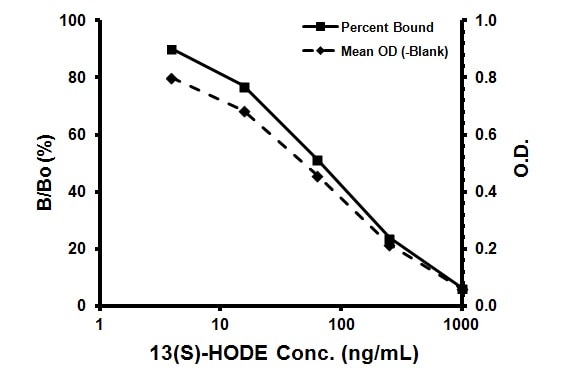13(S)-HODE ELISA kit (ab133044)
Key features and details
- Sensitivity: 1.6 ng/ml
- Range: 3.9 ng/ml - 1000 ng/ml
- Sample type: Cell Lysate, Saliva, Serum, Tissue, Tissue Culture Media
- Detection method: Colorimetric
- Assay type: Competitive
- Reacts with: Human
Overview
-
Product name
13(S)-HODE ELISA kit -
Detection method
Colorimetric -
Precision
Intra-assay Sample n Mean SD CV% Sample 16 23ng/ml 7.3% Sample 16 64ng/ml 6.8% Sample 16 105ng/ml 6.4% Inter-assay Sample n Mean SD CV% Sample 8 20ng/ml 11.3% Sample 8 62ng/ml 5.4% Sample 8 99ng/ml 6.1% -
Sample type
Saliva, Serum, Tissue, Cell Lysate, Tissue Culture Media -
Assay type
Competitive -
Sensitivity
1.6 ng/ml -
Range
3.9 ng/ml - 1000 ng/ml -
Recovery
Sample specific recovery Sample type Average % Range Saliva 107 % - % Urine 115 % - % Serum 89.3 % - % Tissue Culture Media 101.6 % - % -
Assay time
3h 00m -
Assay duration
Multiple steps standard assay -
Species reactivity
Reacts with: Human
Predicted to work with: a wide range of other species
-
Product overview
Abcam’s 13(S)-HODE in vitro competitive ELISA (Enzyme-Linked Immunosorbent Assay) kit is designed for the accurate quantitative measurement of 13(S)-HODE in Tissue Culture Media, Human Serum, Saliva and Urine.
A goat anti-rabbit IgG antibody has been precoated onto 96-well plates. Standards or test samples are added to the wells, along with an alkaline phosphatase (AP) conjugated-13(S)-HODE antigen and a polyclonal rabbit antibody specific to 13(S)-HODE. After incubation the excess reagents are washed away. pNpp substrate is added and after a short incubation the enzyme reaction is stopped and the yellow color generated is read at 405 nm. The intensity of the yellow coloration is inversely proportional to the amount of 13(S)-HODE captured in the plate.
-
Notes
The major Human dietary poly-unsaturated fatty acid is linoleic acid, an essential fatty acid that can be metabolized to either 13-hydroxyoctadecadienoic acid via the lipoxygenase [13(S)-HODE] or P450 [13(R)-HODE] pathways or to 15-hydroxyeicosatetraenoic acid [15(S)-HETE] via the cyclooxygenase pathway. Changes in the intra-cellular ratio of 13(S)-HODE to 15(S)-HETE have been linked to a number of physiological conditions dominated by cancer and cardiovascular diseases. 13(S)-HODE helps to mediate cellular adhesion properties and excessive proliferation that is critical in the formation of tumors, metastasies and artherogenic plaques. Continuously synthesized in non-stimulated vessel epithelia, 13(S)-HODE remains associated with the vitronectin receptor, an ubiquitous integrin adhesion molecule. Cell surfaces become adhesive when HODE concentrations decline, allowing the vitronectin receptor to relocate to the cell surface.
Cross Reactivity
Compound Cross Reactivity % 13(S)-HODE 100 13(R)-HODE 2 13-KODE 0.48 Linoleic Acid 0.31 γ-Linolenic Acid 0.28 9(S)-HODE 0.13 12(R)-HETE 0.07 15(S)-HETE 0.03 12(S)-HETE Arachidonic Acid DGLA 5(S)-HETE PGE1 -
Platform
Microplate
Properties
-
Storage instructions
Please refer to protocols. -
Components 1 x 96 tests 13(S)-HODE Alkaline Phosphatase Conjugate 1 x 5ml 13(S)-HODE Antibody 1 x 5ml 13(S)-HODE Standard 1 x 0.5ml Assay Buffer 1 x 27ml Goat anti-rabbit IgG Microplate (12 x 8 wells) 1 unit Plate Sealer 2 units pNpp Substrate 1 x 20ml Stop Solution 1 x 5ml Wash Buffer Concentrate (20X Conc.) 1 x 27ml -
Research areas





